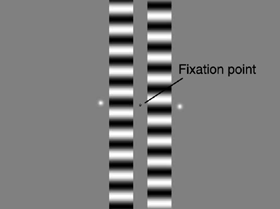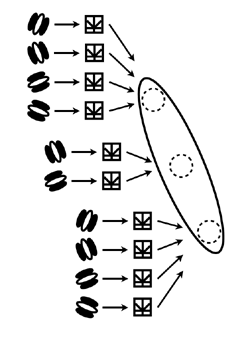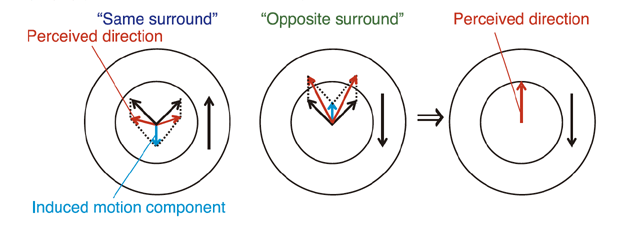The apparent offset of the position of a flashed stimulus toward the motion direction involves pre-attentive motion processing

Among lots of interesting visual phenomena, one of the most striking illusions is the apparent position offset of a briefly flashed stimulus or a stimulus with a blurred contour in the direction of motion nearby. Accumulating evidence supports the view that various mechanisms from low to high are involved in these illusions. But does such an effect of apparent position offset in a flashed stimulus (the flash-drag effect) necessarily require our conscious attention? Is a pre-attentive motion stimulus still able to cause the flash-drag effect?
Taiki Fukiage (master-course graduate student), collaborator Prof. David Whitney (UC Berkeley), and Murakami measured the perceived position of a briefly flashed tiny light spot in the vicinity of a moving pattern, as shown in the figure. As the motion stimulus, we used a random motion that randomly changed the motion direction and two-frame apparent motion stimulus, and found that these impoverished stimuli still produced the flash-drag effect.
One cannot predict what happens next in random motion, and as such, random motion is indifferent to expectation, perceptual set, or attention. That this motion still produces the illusion is viewed as evidence that a pre-attentive visual motion mechanism is sufficient in producing the illusion; this indicates that operating principles such as making maximum use of nearby information to compensate for a poor signal to noise ratio are already implemented in early visual processing stages. This consideration, however, does not preclude involvement of higher-order mechanisms, but instead implies the possibility that the same operating principle works at different stages having different computaional resourcese, from lower stages to higher stages, calculating the best solution at each stage.
A tilt aftereffect reveals interrelationship between orientation filters in two distinct stages in the brain

The human early visual system contains mechanisms called orientation filters, each sensitive to a specific orientation (tilt of light in the image). A first-stage, small-sized filter is sensitive to orientation defined by luminance (light intensity) variation such as black and white. The luminance signals that passed through these filters are then transformed to contrast signals indicating a difference in luminance relative to the mean background luminance, and enter a second-stage, large-sized filter. Between these filters, it is largely unknown whether any first-stage filter non-selectively sends signals to a second-stage filter, or whether the filters with the same orientation preference wire together.
Kenji Kobayashi (master-course graduate student), Masahiko Terao (JSPS Research Fellow), and Murakami took advantage of the tilt aftereffect that occurs in the opposite direction after prolonged observation to a specific tilt, to investigate interrelationship between filters. As shown in the schematic figure, we constructed a large tilt configuration with small black-and-white element stripes, and measured the strength of the aftereffect after adaptation to the whole stimulus. Results indicated that a strong aftereffect occurred when either the parallel or perpendicular orientation in the element stripes that constructed a larger orientation preferred by the second-stage filter.
Our results indicate a facilitatory interaction between the processing of luminance-defined orientation and the subsequent processing of contrast-defined orientation. Our modern life is full of artificial illuminations, in which minimum elements and patterns constructed by such elements are not related to each other. An interpretation of this study might be that, given orientations in a desirable visual pattern, pixels or minimum elements of illumination should also have the parallel or perpendicular orientation to maximize our visual processing in the brain. We hope this research will have a link to future proposals of new graphic schemes offering optimal orientation sharpness despite limited spatial resolution.
Whether dots moving in two directions appear coherent or transparent depends on surrounding motion

When a region contains lots of tiny dots all moving in one direction, the region appears as a plane moving in this direction. Also, when each dot is moving in one of two possible directions, two moving planes are perceived simultaneously (motion transparency) if the difference between the motion directions is large enough, whereas one integrated motion is seen if the directional difference is small. On the other hand, it is also known that another motion in the surround can affect the perceived motion in the surrounded region. When the surrounding motion is upward, a central region appears to move downward even if it is actually stationary (induced motion); given left-and-up motion in the central region, this physical motion and induced motion apparently sum to yield the perceived motion whose direction seems more inclined.
Hiromasa Takemura (doctoral-course graduate student, JSPS Research Fellow), collaborator Satohiro Tajima (Nagano Station, Japan Broadcasting Corporation), and Murakami examined how motion transparency and induced motion are related to each other by a motion judgment task; a central region, in which participants were asked to report the motion direction(s), contained dots moving in either a left-up or a right-up direction, whereas a surrounding region contained dots moving in yet another direction. We found that, under the condition in which the directional difference in the central region was 90 degrees, the two motions were more easily discerned as two and furthermore appeared more inclined when the surround dots moved upward and induced downward induced motion in the central region, than when the surround dots moved either upward or downward (control condition). Also, the central dots appeared to move in one integrated direction when the surround dots moved downward and induced upward induced motion in the central region.
Our results indicate that an identical movie in the central region can appear differently depending upon the presence of motion in the surrounding region, such that induced motion artificially induced in the central region evokes an interaction with the actual motion there, thereby boosting or reducing the rate of the two-plane solution. If a stimulus would otherwise appear as an integrated motion and therefore would fall within the visual system's resolution limit, our directional discriminability can be enhanced by adding induced motion in a neat way so that the resulting apparent motions should point at appropriate directions. This suggests that the visual system's internal noise effect that limits our discriminability is located at some stage that is affected by the mechanism underlying induced motion, and that configuration allowing nice spatial interactions will be useful for optimization of our sensitivity despite internal noises.